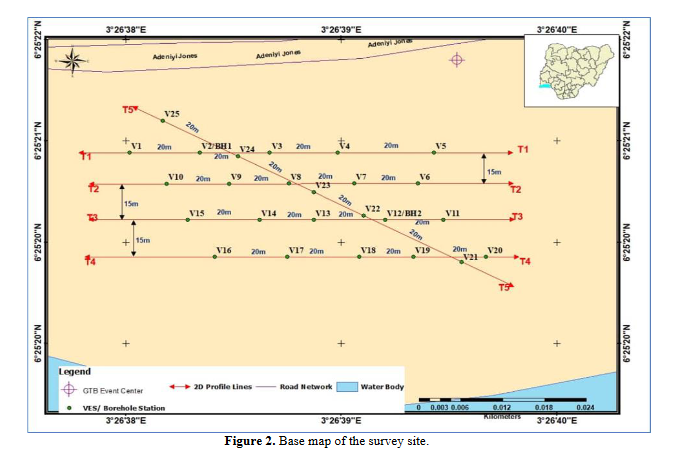Subsurface Integrity Assessments of a Proposed Plaza Building at Oniru Lekki, Lagos, South-western Nigeria, Using Geoelectrical and Geotechnical Methods of Investigations
DOI:
https://doi.org/10.53848/ssstj.v10i1.425Keywords:
Assessment, Building-foundation, Integrity, Geotechnical, SubsurfaceAbstract
Subsurface integrity assessment for building foundation using geophysical and geotechnical methods was carried out at Oniru, Eti- Osa, Lagos State. A total of twenty-five Vertical Electrical Sounding (VES), five 2-D Resistivity Imaging Survey traverses and two borings with Standard Penetration Test (SPT) were carried out at the study site. The acquired data were processed quantitatively using partial curve matching and computer iteration technique to generate the geoelectric sections, the 2-D model and the SPT logs. The VES results revealed five to six geologic units corresponding to topsoil, clayey sand, sandy clay, clay/peat, and sand while the 2-D resistivity structure corresponds with the VES result. The borehole log reveals sand layers having an N-value of 22-30 which is indicative of medium-dense, brown (medium to fine) sand with occasional gravels from depth 1.50 - 7.50m. The borehole log information correlates well with the VES/2-D result. For the sand layer which connotes dense, grey (medium to fine) sand with occasional gravels from a depth 7.50 – 15.75m with N-value ranging from 26–30m. The study analysis shows that the proposed building could be placed on the dense sand at depth 7.50 – 15.75m, this, however, should depend on the proposed load, length, and breadth of the proposed building. This study has provided useful information about the subsurface condition for engineering structure and zone suitable for the proposed foundation.
References
Adebajo, K. (2005). A position paper by the Nigerian Institute of Structural Engineers a division of the Nigerian Society of Engineers (NSE) on Recent Structural Collapses in Nigeria and the Prevention of Future Incidences.
Afolabi, O. J., Oluwaji, O. A., & Fashola, O. K. (2017). Socio-economic impact of road traffic congestion on urban mobility: A case study of Ikeja Local Government Area of Lagos State, Nigeria. The Pacific Journal of Science and Technology, 18(2),246-255.
Aizebeokhai, A. P. (2010). 2D and 3D geoelectrical resistivity imaging: Theory and field design. Scientific Research and Essays, 5(23), 3592-3605.
Aizebeokhai, A. P., Olayinka, A. I., & Singh, V. S. (2010). Application of 2D and 3D geoelectrical resistivity imaging for engineering site investigation in a crystalline basement terrain, southwestern Nigeria. Environmental Earth Sciences, 61, 1481-1492.
Akintorinwa, O. J., & Abiola, O. (2011). Subsoil evaluation for pre-foundation study using geophysical and geotechnical approach. Journal of Emerging Trends in Engineering and Applied Sciences (JETEAS), 2(5), 858-863.
Amidu, S. A., & Olayinka, A. I. (2006). Environmental assessment of sewage disposal systems using 2D electrical-resistivity imaging and geochemical analysis: A case study from Ibadan, southwestern Nigeria. Environmental & Engineering Geoscience, 12(3), 261-272.
Ayolabi, E. A., Adeoti, L., Oshinlaja, N. A, Adeosun, I. O., & Idowu, O. I. (2009). Seismic refraction and resistivity studies of part of Igbogbo township, South-west Nigeria. Journal of Scientific Research and Development, 11, 42-61.
Ayolabi, E. A., Enoh, I. J. E., & Folorunso, A. F. (2013). Engineering site characterization using 2-D and 3-D electrical resistivity tomography. Earth Science Research, 2(1), 133-142.
Bhattacharya, P. K., & Patra, H. P. (1968). Direct current geoelectric sounding. Amsterdam: Elsevier Publishing.
Coker, J. O. (2015). Geophysical and geotechnical assessment of foundation failure: A case study of library complex area, Lagos State
Polytechnic, Ikorodu, Lagos, Nigeria. Research Journal in Engineering and Applied Sciences, 3(7), 40-48.
Ehibor, I. U., & Akpokodje, E. G. (2019). The subsurface soil stratigraphy and foundation quality of soils underlying Uyo town, Eastern Niger Delta, Nigeria. Journal of Earth Sciences and Geotechnical Engineering, 9(2), 1-12.
Fajana, A. O., Olaseeni, O. G., Bamidele, O. E., & Olabode, O. P. (2016). Geophysical and geotechnical investigation for post foundation studies, Faculty of Social Sciences and Humanities, Federal University Oye Ekiti. Journal of Engineering and Technology, 1, 62-66.
Jones, H. A., & Hockey, R. D. (1964). The geology of part of Southwestern Nigeria. Geological Survey of Nigeria Bulletin, 31, 87.
Kearey, P., Brook, M., & Hill, I. (2002). An introduction to geophysical exploration (3rd ed.). Oxford: Blackwell Science.
Kunetz, G. (1966). Principles of direct current resistivity prospecting. Berlin: Gebruder Borntraeger.
Loke, M. H. (2001). Electrical imaging surveys for environmental and engineering studies: 2-D and 3-D electrical imaging surveys. RES2DINV Manual. 129.
McDowell, P. W., Barker, R. D., Butcher, A. P., Culshaw, M. G., Jackson, P. D., McCann, D. M., ... Arthur, J. C. R. (2002). Geophysics in engineering investigations. London: CIRIA.
Milsom, J. (2003). Field geophysics. New York: John Wiley & Sons.
Olorunfemi, M. O., & Mesida, E. A. (1987). Engineering geophysics and its application in engineering site investigation – Case study from Ile-Ife area. The Nigerian Engineer, 22, 57-66.
Oyedele, K. F., & Okoh, C. (2011). Subsoil investigation using integrated methods at Lagos, Nigeria. Journal of Geology and Mining Research, 3(7), 169-179.
Roth, M. J. S., Mackey, J. R., Mackey, C., & Nyquist, J. E. (2002). A case study of the reliability of multielectrode earth resistivity testing for geotechnical investigations in karst terrains. Engineering Geology, 65, 225-232.
Sanchez-Salinero, I., Roesset, J. M., Shao, K. Y., Stokoe II, K. H., & Rix, G. J. (1987). Analytical evaluation of variables affecting surface wave testing of pavements.Transportation Research Record, 1136, 86-95.













